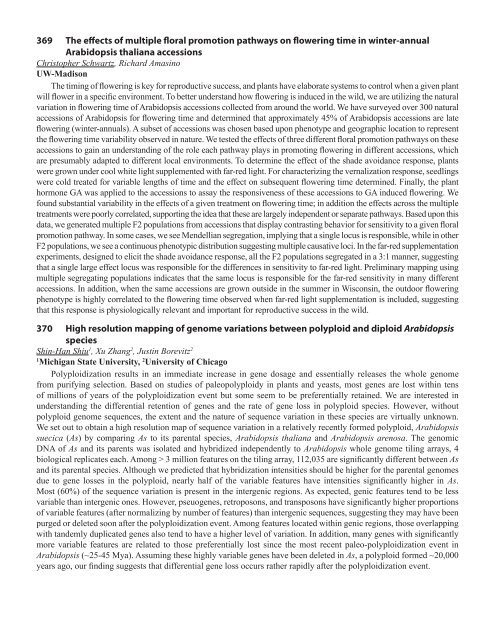75 Integrating Membrane Transport with Male Gametophyte ... - TAIR
75 Integrating Membrane Transport with Male Gametophyte ... - TAIR
75 Integrating Membrane Transport with Male Gametophyte ... - TAIR
Create successful ePaper yourself
Turn your PDF publications into a flip-book with our unique Google optimized e-Paper software.
369 The effects of multiple floral promotion pathways on flowering time in winter-annual<br />
Arabidopsis thaliana accessions<br />
Christopher Schwartz, Richard Amasino<br />
UW-Madison<br />
The timing of flowering is key for reproductive success, and plants have elaborate systems to control when a given plant<br />
will flower in a specific environment. To better understand how flowering is induced in the wild, we are utilizing the natural<br />
variation in flowering time of Arabidopsis accessions collected from around the world. We have surveyed over 300 natural<br />
accessions of Arabidopsis for flowering time and determined that approximately 45% of Arabidopsis accessions are late<br />
flowering (winter-annuals). A subset of accessions was chosen based upon phenotype and geographic location to represent<br />
the flowering time variability observed in nature. We tested the effects of three different floral promotion pathways on these<br />
accessions to gain an understanding of the role each pathway plays in promoting flowering in different accessions, which<br />
are presumably adapted to different local environments. To determine the effect of the shade avoidance response, plants<br />
were grown under cool white light supplemented <strong>with</strong> far-red light. For characterizing the vernalization response, seedlings<br />
were cold treated for variable lengths of time and the effect on subsequent flowering time determined. Finally, the plant<br />
hormone GA was applied to the accessions to assay the responsiveness of these accessions to GA induced flowering. We<br />
found substantial variability in the effects of a given treatment on flowering time; in addition the effects across the multiple<br />
treatments were poorly correlated, supporting the idea that these are largely independent or separate pathways. Based upon this<br />
data, we generated multiple F2 populations from accessions that display contrasting behavior for sensitivity to a given floral<br />
promotion pathway. In some cases, we see Mendellian segregation, implying that a single locus is responsible, while in other<br />
F2 populations, we see a continuous phenotypic distribution suggesting multiple causative loci. In the far-red supplementation<br />
experiments, designed to elicit the shade avoidance response, all the F2 populations segregated in a 3:1 manner, suggesting<br />
that a single large effect locus was responsible for the differences in sensitivity to far-red light. Preliminary mapping using<br />
multiple segregating populations indicates that the same locus is responsible for the far-red sensitivity in many different<br />
accessions. In addition, when the same accessions are grown outside in the summer in Wisconsin, the outdoor flowering<br />
phenotype is highly correlated to the flowering time observed when far-red light supplementation is included, suggesting<br />
that this response is physiologically relevant and important for reproductive success in the wild.<br />
370 High resolution mapping of genome variations between polyploid and diploid Arabidopsis<br />
species<br />
Shin-Han Shiu 1 , Xu Zhang 2 , Justin Borevitz 2<br />
1<br />
Michigan State University, 2 University of Chicago<br />
Polyploidization results in an immediate increase in gene dosage and essentially releases the whole genome<br />
from purifying selection. Based on studies of paleopolyploidy in plants and yeasts, most genes are lost <strong>with</strong>in tens<br />
of millions of years of the polyploidization event but some seem to be preferentially retained. We are interested in<br />
understanding the differential retention of genes and the rate of gene loss in polyploid species. However, <strong>with</strong>out<br />
polyploid genome sequences, the extent and the nature of sequence variation in these species are virtually unknown.<br />
We set out to obtain a high resolution map of sequence variation in a relatively recently formed polyploid, Arabidopsis<br />
suecica (As) by comparing As to its parental species, Arabidopsis thaliana and Arabidopsis arenosa. The genomic<br />
DNA of As and its parents was isolated and hybridized independently to Arabidopsis whole genome tiling arrays, 4<br />
biological replicates each. Among > 3 million features on the tiling array, 112,035 are significantly different between As<br />
and its parental species. Although we predicted that hybridization intensities should be higher for the parental genomes<br />
due to gene losses in the polyploid, nearly half of the variable features have intensities significantly higher in As.<br />
Most (60%) of the sequence variation is present in the intergenic regions. As expected, genic features tend to be less<br />
variable than intergenic ones. However, pseuogenes, retroposons, and transposons have significantly higher proportions<br />
of variable features (after normalizing by number of features) than intergenic sequences, suggesting they may have been<br />
purged or deleted soon after the polyploidization event. Among features located <strong>with</strong>in genic regions, those overlapping<br />
<strong>with</strong> tandemly duplicated genes also tend to have a higher level of variation. In addition, many genes <strong>with</strong> significantly<br />
more variable features are related to those preferentially lost since the most recent paleo-polyploidization event in<br />
Arabidopsis (~25-45 Mya). Assuming these highly variable genes have been deleted in As, a polyploid formed ~20,000<br />
years ago, our finding suggests that differential gene loss occurs rather rapidly after the polyploidization event.





